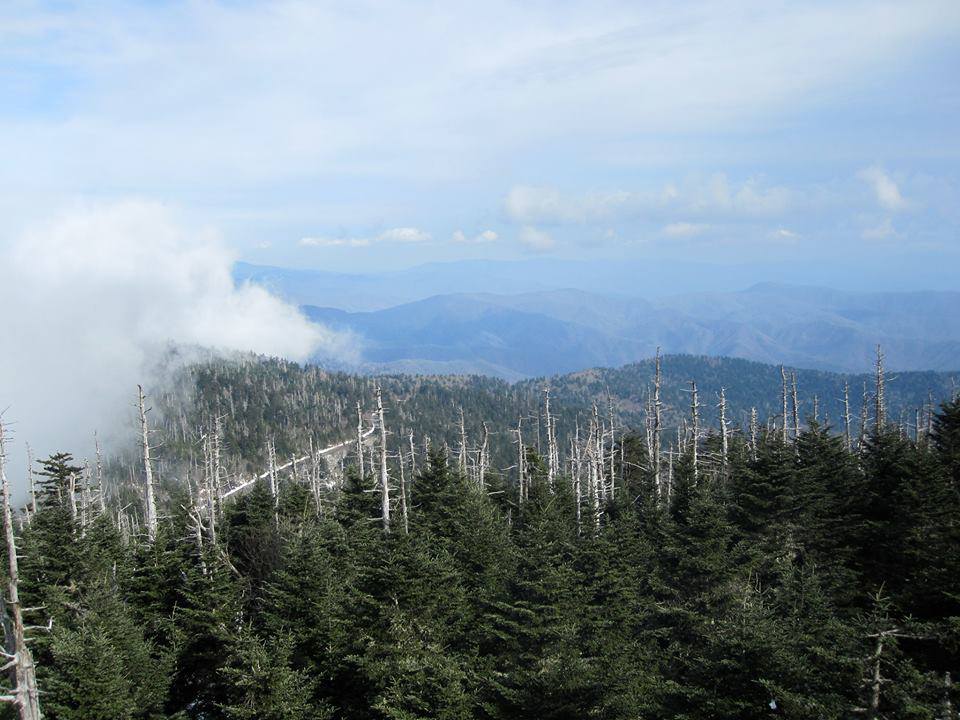Clingmans Dome is the highest point in the Great Smoky Mountains National Park and along the Appalachian Trail. It is also the highest point in the state of Tennessee. At 2025 meters (6643 feet) tall, Clingmans Dome is the third highest mountain east of the Mississippi River. The attraction is half in Tennessee and half in North Carolina.
I hiked the Smoky Mountains in November 2012 and visited the observation tower at the top of Clingmans Dome. I climbed a steep, icy path for about 0.8 kilometers (0.5 miles) after a brief snowfall to get to the tower. The incredible view was worth the work. For a brief period, I could see spectacular landscapes all around me from the top of the tower. On days when the weather is clear, you can see over 161 kilometers (100 miles) into the distance, and the tower provides 360° views of this vast expanse of land. The land that is visible extends over seven states. I could see breathtaking features for a brief period when I was at the top; however, the clouds rolled in soon after I started taking pictures. The clouds are not the only interference; air pollution in the area sometimes limits visibility to less than 32 kilometers (20 miles) around.
Clingmans Dome receives over 2.4 meters (8 feet) of rain during wetter years. The average rainfall in the entire elevated region amounts to approximately 216 centimeters (85 inches) per year. It also is much cooler at this peak. Temperatures here can be 10 to 20 degrees F cooler. These precipitation rates and temperatures make the area a perfect environment for spruce-fir forests.
Unfortunately, the fir trees in this area are suffering. The balsam woolly adelgid (Adelges piceae) is an insect that has been introduced to the area from European tree imports. Fir trees used to be the dominant tree in this high elevation region; now, their populations are dying. The insects inject toxic chemicals into the fir trees, which block nutrients from being distributed throughout the bodies of the trees. This “starves” the trees, which causes them to die. As I looked out at the forested area around Clingmans Dome, I could see many dead standing trees, or snags, dotting the landscape.
I took this photo in November 2012 from the top of the observation tower at Clingmans Dome. Note the snags in the image.
References:
http://www.nps.gov/grsm/
http://www.nps.gov/grsm/
http://
For more information on Smoky Mountain geology, please see: https://www.facebook.com/
For more information on features found in the Great Smoky Mountains National Park, please see:https://www.facebook.com/
I hiked the Smoky Mountains in November 2012 and visited the observation tower at the top of Clingmans Dome. I climbed a steep, icy path for about 0.8 kilometers (0.5 miles) after a brief snowfall to get to the tower. The incredible view was worth the work. For a brief period, I could see spectacular landscapes all around me from the top of the tower. On days when the weather is clear, you can see over 161 kilometers (100 miles) into the distance, and the tower provides 360° views of this vast expanse of land. The land that is visible extends over seven states. I could see breathtaking features for a brief period when I was at the top; however, the clouds rolled in soon after I started taking pictures. The clouds are not the only interference; air pollution in the area sometimes limits visibility to less than 32 kilometers (20 miles) around.
Clingmans Dome receives over 2.4 meters (8 feet) of rain during wetter years. The average rainfall in the entire elevated region amounts to approximately 216 centimeters (85 inches) per year. It also is much cooler at this peak. Temperatures here can be 10 to 20 degrees F cooler. These precipitation rates and temperatures make the area a perfect environment for spruce-fir forests.
Unfortunately, the fir trees in this area are suffering. The balsam woolly adelgid (Adelges piceae) is an insect that has been introduced to the area from European tree imports. Fir trees used to be the dominant tree in this high elevation region; now, their populations are dying. The insects inject toxic chemicals into the fir trees, which block nutrients from being distributed throughout the bodies of the trees. This “starves” the trees, which causes them to die. As I looked out at the forested area around Clingmans Dome, I could see many dead standing trees, or snags, dotting the landscape.
I took this photo in November 2012 from the top of the observation tower at Clingmans Dome. Note the snags in the image.
References:
http://www.nps.gov/grsm/
http://www.nps.gov/grsm/
http://
For more information on Smoky Mountain geology, please see: https://www.facebook.com/
For more information on features found in the Great Smoky Mountains National Park, please see:https://www.facebook.com/


No comments:
Post a Comment